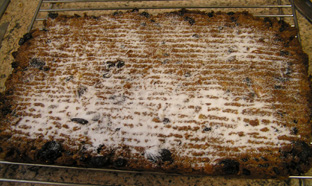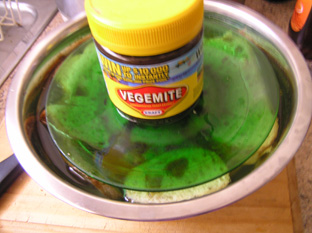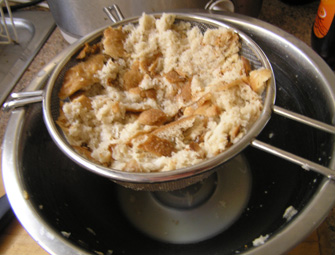 This recipe comes from my Austrian grandmother, and is basically a really delicious way to use up stale bread. As a child, this was one of my favourite foods – its spicy stodginess reminded me of Christmas pudding, and it even looked Christmassy, with the sugar sprinkled like snow over the furrows in the top of the cake. As an adult, I look at this recipe and wonder if it was a product of the Depression or more likely of rationing. One egg, a couple of spoonfuls of sugar, 60g of butter or margarine, and a fair bit of dried fruit, and a lot of stale bread… It does sound a lot like the sort of sweet thing you make when you don’t have much in the way of butter, sugar or eggs, and can’t afford to waste bread.
This recipe comes from my Austrian grandmother, and is basically a really delicious way to use up stale bread. As a child, this was one of my favourite foods – its spicy stodginess reminded me of Christmas pudding, and it even looked Christmassy, with the sugar sprinkled like snow over the furrows in the top of the cake. As an adult, I look at this recipe and wonder if it was a product of the Depression or more likely of rationing. One egg, a couple of spoonfuls of sugar, 60g of butter or margarine, and a fair bit of dried fruit, and a lot of stale bread… It does sound a lot like the sort of sweet thing you make when you don’t have much in the way of butter, sugar or eggs, and can’t afford to waste bread.
While I will give you the recipe as it was given to me, you shouldn’t worry too much about quantities. Nine slices of bread is a very approximate volume – a few slices more or less don’t make much difference. You could add a dab more butter if you needed to, but you’ll probably be fine. This recipe works with awful cotton-wool white bread or with lovely Italian sourdough bread or anything in between. I’ve even made it with wholegrain breads and rye. Today’s version is made with the heel ends of a couple of loaves of good farmers’ market bread (the two of us can never get through a really good loaf before it goes stale, so I freeze the bits we don’t get to for this very purpose) – one plain, the other flavoured with dried figs and fennel seed. It’s going to be delicious. The dried fruit I had on hand happened to be raisins, currants, mixed peel and some dried apricots – Oma mostly made it with sultanas and mixed peel. You can make it with whatever you like – this is more an idea than a recipe, I think. And a very good one, too.
It’s lovely served warm with icecream, or cold in lunchboxes. We often eat it for breakfast.
Your shopping list
9 sluces stale bread with crusts on 200 g dried fruit (I usually push this up to 225-250g) 1 tbsp brown or raw sugar 2-3 tsp mixed spice (I usually put in a teaspoon each of cinnamon and ginger, and half a teaspoon each of nutmeg and cloves or allspice) zest of half a lemon 60 g softened butter or margarine 1 egg a little caster sugar, for sprinkling
Now what will you do with it?
Put the bread in a bowl and cover with cold water. You may need to weigh the bread down with a plate, because it will try to bob up. Leave it for at least half an hour.
Preheat the oven to 190°C. Drain the bread and squeeze it as hard as you can to get as much water out of it as possible. The really tricky part here is squeezing the bread in your hand and not having the soft mushy bread bits squeezing out through your fingers along with the water. I generally do this for a bit, and then chuck the whole lot into a seive and press down as hard as I can.
Incidentally, the first time I made this, my then flatmates watched me get to this point and then fled the kitchen with cries of disgust and refused to sample any of it when it was cooked. It’s just wet bread, people! Not exciting, I admit, but hardly revolting. Needless to say, that flatmate relationship didn’t last long…
My recipe now says ‘beat bread with a fork until smooth’, which suggests some truly frightening things about the kind of bread Oma had access to when she wrote this one down. Or perhaps she was just a lot more patient than me. This would not be very difficult. In my experience, a sturdy sourdough or good quality white or wholemeal bread never gets completely smooth, but you want to try to break it up as much as possible.
Add the softened butter, egg, spices, sugar, dried fruit and lemon zest and mix well. I find this works best if I start by adding the butter, egg, spices and sugar, mix it all together at which point smoothness might actually be achieved) and then stir in the fruit and zest.
Spoon into a greased and lined slice tin and bake for 1- 1 1/2 hours, or until done. Which you can tell it is because if you poke at it, it bounces back at you a bit.
Sprinkle with caster sugar before serving.
Variations
This pudding is already vegetarian and nut free, of course, and as desserts go, it’s relatively low GI, assuming the bread you used was low-GI in the first place. It’s pretty low in sugar and fat, too. If you want to make it dairy-free, it works brilliantly with Nuttelex or your dairy-free margarine of choice. I suspect it could be made egg-free with a mashed banana or maybe 60g or so of smooth tofu, because there isn’t all that much egg in there to start with.
What it isn’t and probably can’t be is gluten-free. I’m not an expert on gluten-free breads, but they do tend to be a bit on the crumbly side, and I think if you put them into water they would fall apart too much to hold the pudding together. Sorry.
In terms of flavour, you could do anything with this. For some reason my brain is saying “choc chip and dried cranberry bread pudding!” to me right now, and I can’t see any reason why that wouldn’t work. I might not use the spices for that. If you want to really go the Christmas Pudding flavour route, you could add a little brandy or marsala with the fruit (or start by letting them soak up some brandy or sherry overnight). It’s actually not very sweet, and you could probably make a savoury pudding by omitting the sugar, spices and dried fruit and adding things like cheese, paprika, sun dried tomatoes, capsicum, and grated carrots and zucchini inplace of the fruit to make a savoury picnic slice. Actually, I think I might give that a try next time, just to see how it works.






3 comments for “Recipe: Bread Pudding”